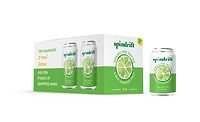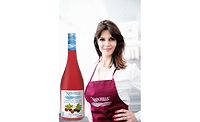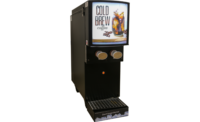Cott Corporation sees bright future with HOD water
Cott’s services business reaches 2.5 million customers

When it comes to beverage consumption choices, many will highlight that consumers are not at a loss for solutions. However, data shows that on a volume basis, one category has emerged as the latest favorite: bottled water. According to a May 2018 release from the International Bottled Water Association (IBWA) and Beverage Marketing Corporation (BMC), bottled water was the No. 1 beverage product in the United States by volume, for the second year in a row.
Given the volume growth of packaged water, beverage manufacturers have taken notice of how consumers are reaching for hydration beverages over sweeter options, prompting them to rethink their own portfolios.
This shifting sentiment caught the attention of Cott Corporation, Tampa, Fla., and Mississauga, Canada, back in 2013, thereby paving the way for the beverage manufacturer to create a new identity for itself.
“We have an annual process whereby we look out over the next three, five, seven and 10 years, which culminates in a Global Senior Leadership meeting in the third quarter of each year,” explains Tom Harrington, Chief Executive Officer (CEO) of Cott. “As a part of this process in 2013, our senior leadership team lead by Jerry Fowden (our CEO during the transformation) and Jay Wells, CFO of Cott determined that the sugary sweetened beverage market would continue to decline as the consumer was shifting consumption from sugary sweetened beverages and toward healthier alternatives, including a variety of products within the water and coffee categories.”
However, that was not the only factor impacting the then private-label beverage manufacturer. “In addition to this shift in consumer behavior, we also experienced pricing and margin pressures from our retail customers,” Harrington details. “This price and margin squeeze was occurring during a time period with relatively low commodity costs, and management forecasted potential future challenges in the event our commodity prices increased.
“Even with these pressures on our business, we consistently delivered strong free cash flow but had not been rewarded by the markets in our stock price,” he continues. “With this backdrop, we developed a strategic plan, which incorporated a shift from a focus on small bolt-on acquisitions to larger scale acquisitions that would allow us to quickly move the needle and begin to transition our business and diversify our revenues and profits with meaningfully lower customer concentration.”
Through a strategic plan review process, the coffee and water markets, particularly home office delivery (HOD), caught Cott’s attention. Harrington explains that the company found that it could seize an opportunity to be the leader in the HOD water market while lowering its customer concentration and exposure to commodities.
Although the prospectus on HOD water was most desirable, the company found the market for HOD and foodservice or “on-the-go” coffee to be appealing as well.
“HOD was also a channel with good historical growth with expected growth many years out into the future,” Harrington says. “In addition to HOD water, we also liked the ‘on-the-go’ coffee channel and bookmarked S&D Coffee as the business that we would like to have within our portfolio as it was a leader in not only the roasting and grinding of coffee and blending of tea for many of the well-known quick-service restaurants, convenience stores and distributors throughout the U.S., but it was also the only vertically integrated coffee and manufacturer with extract production capabilities relative to its peers.
“Being a key supplier within the ‘sticky’ distribution channel for so many well-known customers as well as being a leader within the fast-growing extract channel, (think cold-brew coffee, flavored coffees, the concentrates used to make ready-to-drink coffee, etc.), we looked at S&D as the ideal business to acquire when making our move into the ‘on-the-go’ coffee channel,” he continued.
Buying & Selling
With the vision to become the leader in HOD water and coffee, Cott began its merger and acquisition (M&A) activity in 2014. The first acquisition occurred in May of that year with the purchase of Aimia Foods, a provider of hot drinks to foodservice and catering channels in the United Kingdom.
Toward the end of 2014, Cott made its initial foray into the North American HOD water market with the purchase of DS Services, a direct-to-consumer services provider across home and office delivery water, office coffee and filtration services in the United States.
The company continued to add to its arsenal in 2016 with the acquisitions of Aquaterra, a Canadian distributor of home and office delivery; S&D Coffee & Tea, a custom coffee roaster and distributor of coffee and tea-based beverage solutions for the U.S. foodservice market; and Eden Springs, a European direct-to-consumer home and office delivery water and office coffee services provider with operations in 18 countries.
When making these acquisitions, Harrington details that it was a collection of factors that motivated Cott to make these M&A moves.
“The key characteristics of the HOD market that appealed to our team — and myself as I was the President of DS Services when Cott acquired the business — was the following: minimal customer concentrations; the ability to implement price increases to offset inflation; limited exposure to commodities, for example, we have energy surcharges to offset fuel costs, and our bottles are reused 50 plus times thereby minimizing any increases in the costs of the materials; [and] growing categories with the ability to leverage an international footprint and in turn drive additional profits within the businesses,” he says.
Also part of Cott’s transformation was the sell-off of its legacy carbonated soft drink traditional beverage manufacturing business. In 2018, this was completed with the $1.25 billion sale to Refresco, which included Cott’s North America, United Kingdom and Mexico beverage manufacturing businesses.
Harrington notes that it wasn’t necessary to divest from this business; however, by doing so, it allowed Cott to focus on its new business ventures while significantly reducing the leverage of the business.
Although Cott already has made high-profile M&A moves, the company realizes that more acquisitions will likely be part of its future as it strives to create more value for its shareholders and customers.
“Throughout 2018, we noted that we would execute approximately $40 to $60 million of tuck-in or smaller acquisitions,” Harrington says. “We executed against this priority in 2018 completing several tuck-in acquisitions as well as the acquisition of Mountain Valley, which is a fast-growing premium American branded spring water bottled in 5-gallon glass bottles as well as a variety of other spring, sparkling and flavored water bottle formats, which will benefit not only our HOD water channel but also has many opportunities in foodservice. In addition, we have noted that we would look at more scale opportunities over the coming years in the areas of HOD water, filtration and coffee, tea and extracts with HOD water being the primary area that we would look to grow ahead of the other areas.”
‘Routed’ for success
Following Cott’s disposition of its traditional business, the business now sees more concentration from its Route Based Services operating segment. According to Harrington, the Route Based Services operating segment accounts for 70 percent of the company’s revenue and more than 80 percent of its earnings before interest, tax, depreciation and amortization (EBITDA) with the North American division of the Route Based Services segment accounting for over 70 percent of the revenue of the Route Based Services operating segment.
“Within Route Based Services, our water delivery services (primarily the 3- and 5-gallon returnable water bottles) generates around 70 percent of the revenues, while office coffee services generates 10-12 percent of revenues, and filtration generates 3-4 percent,” Harrington details.
Across all of its markets, Cott’s services business reaches 2.5 million customers while the company’s U.S. HOD business, covers more than 90 percent of the U.S. population, serving 1.7 million customers. Of those 1.7 million U.S. customers, 1.4 million are HOD water customers, Harrington says.
When Cott acquired the HOD businesses, it was able to retain the heritage brands for those regions. Those brands include Hinckley Springs in the Chicagoland area, Alhambra in Northern California, Sparkletts in Southern California and Texas, and Kentwood in Louisiana. It also offers Mountain Valley spring and sparkling water, a water that has been continuously bottled in Hot Springs, Ark., since 1871, the company says.
Beyond its variety of water brands, Cott also offers a plethora of packaging formats that help serve the customized needs of its consumer and commercial customers.
“The key driver of our business and the success of our business is 3- and 5-gallon returnable water bottles, but we also offer a variety of other products such as 500-ml single-serve cases of spring and purified water; premium glass in 5-gallon, 333-ml, 500-ml and 1-liter formats; sparkling water in a variety of packages; sparkling flavored water in a variety of packages; in addition to a variety of other ancillary or partner products such as La Croix, Voss and FIJI,” Harrington says. “We also offer a variety of licensed products within our route-based coffee services program including Starbucks, Lavazza, Mars and Keurig. And let’s not forget our product offerings in the fast growing filtration category where we service over 150,000 customers across our footprint with this being one area that we would look to develop more scale over the next three to five years.”
Because the Route Based Services division is direct-to-consumer, those working in the field are the main point of contact for consumers. Harrington explains that the company works to support these route service representatives, thereby ensuring a positive experience for the consumer.
“We have dedicated route service representatives, the face of the company, that deliver product directly to our customers as well as a state-of-the-art customer care center, the voice of the company,” he says. “We track our performance daily to ensure that we are satisfying customers. We are currently experiencing the lowest quit rates that we have seen within our North American Route Based business. This is due in large part to a number of initiatives that we have implemented over the last few years including updating our route handhelds to iPhones and linking them to our customer care center, which we consolidated into one state-of-the-art center from three separate centers back in 2015. We continue to upgrade our customer experience in areas of website design and flexibility, product offerings, as well as a mobile app that we have in development.”
Cott also continues to bolster its product portfolio. Although still water makes up large portion of its HOD water share, it does offer sparkling options and is looking to add more.
“This is an area where we have started to expand — although it does not make up a large portion of our current sales, we would expect it to grow over the coming years as we improve our cross-selling capabilities, expand our products within our footprint and add new products,” Harrington explains. “For instance, we acquired Mountain Valley Springs in October of 2018, an American premium-glass spring, sparkling and flavored bottled water company. We would look to start increasing the availability and sales of these products over the coming years.
“In 2019, we have also added the distribution of La Croix, which is a very popular sparkling beverage to our product offerings and based upon the success that La Croix has had in retail outlets, we would expect good growth from this new product offering,” he continues. “In addition, we have begun working on a water cooler that has sparkling capabilities, which we will roll out in Europe in 2019, resulting in the ability to deliver our environmentally-friendly returnable bottle with sparkling capabilities.”
However, portfolio expansion is not the only growth models that Cott is examining for its North American markets.
“As we look to 2019 and beyond, we have a variety of growth initiatives and would expect growth to come from increased customers, increased consumption per customer, pricing initiatives, small tuck-in or customer list additions and the benefit of our customer experience initiatives that will drive further cross selling and an increased retention rate,” Harrington explains. “Within North America we have expanded our direct sales force to focus on continuing to grow our commercial customer base throughout our footprint. We have also consistently driven around 25 percent of our new customers from our route service representatives as they benefit by adding additional customers to their routes as they are primarily paid on a commission basis.
“We also have a focused effort in growing our residential customer footprint in the U.S. through the utilization of a booth program in which we capitalize on the customer base of a large retail partner by setting up booths on a weekly basis in their stores,” he continues. “In addition, we have seen a significant increase in customer additions through our online and social media marketing activities.”
Speedy delivery
With more than 2,400 routes dedicated to its North American HOD delivery market alone, Cott understands the importance of streamlining its distribution operations. Across its 20 markets, the company has more than 3,600 routes in total.
To support these operations, Cott’s water route delivery utilizes 10 bay side-load route trucks, while its coffee delivery business features 18 20-foot step vans, Harrington explains. Its equipment service fleet primarily is comprised of cargo vans.
Also key to its delivery support is the use of routing software solutions. “We are currently implementing Omni-tracks in the U.S. and utilize it in Europe for routing,” Harrington says. “Thus far, the software and tools have allowed us to become more efficient throughout our system. We are also working with more fuel-efficient vehicles with ‘clean’ technology in addition to reviewing the opportunity to incorporate propane technology. In addition, we are implementing new fleet software that will reduce our dependency in areas that we have needed to outsource repairs and maintenance — we typically employ our own mechanics but there are times when we utilize third parties due to scheduling conflicts, etc. — and the software is designed to assist us with improving/reducing vehicle downtime both of which will reduce fleet maintenance expenses and increase staff productivity.”
Across the pond
Although Cott has a vast presence throughout the United States and Canada, the reinvented beverage company also maintains notable representation in 17 European markets and Israel.
For in-house operations (customer service, IT and procurement), Cott has a centralized senior management team that works across the 18 markets. However, the day-to-day operations is unique to each country, Harrington explains.
“We do utilize best practices in areas such as marketing, procurement, product offerings, etc. across the business,” he says. “One of the benefits of having 18 different countries is that the diversification allows us to stay on track throughout the year as small hiccups seen in one area are offset by wins in other areas.”
Counter to North America, the European division is primarily made up of commercial accounts. Yet, Cott does see growth potential within the direct-to-consumer market in Europe.
“[W]e see the opportunity to market to residential customers as a future source of growth and we are working on technology that would work better with residences in Europe as they typically have less space within their kitchens relative to North America,” Harrington says. “The service offering, plants, and products are very similar to the U.S.”
Adding specifics, Harrington notes that Western Europe has a larger population of filtration users, while HOD is more desired in Eastern Europe.
“As a result, the western part of Europe is a flat to slight growth market for HOD while we see good growth in Eastern Europe,” he says. “We also offer filtration services and see this as an opportunity as the filtration market has very good growth in both the U.S. and Europe but it is very fragmented and has a much smaller base as there are more HOD placements throughout the areas that we operate in. In terms of filtration versus HOD, we like both channels but find that these products are utilized in different channels of our business. For instance, our small office / home office or SOHO focus within HOD water typically results in coolers being placed in areas that do not have water access so the placement of a filtration unit is not practical.”
Environmental Social and Governance
Cott’s new shape and form also allows it to now focus on areas such as sustainability.
“Sustainability lies at the heart of our company — it’s both our legacy and our future,” Harrington says. “Our products and services are focused on contributing to a sustainable future. We take advantage of environmentally friendly processes that support the health of the planet. Our successful sustainability programs have reduced landfill waste, our carbon footprint and water usage.”
Many of the products used within the HOD water business can be thought of as some of the top environmentally friendly packages currently available, the company says.
“We are able to utilize our 3- and 5-gallon water bottles 50 times before we grind them up and utilize a portion for the next generation of water bottles and the remaining portion is utilized within other plastic recycled materials,” Harrington says. BI
Looking for a reprint of this article?
From high-res PDFs to custom plaques, order your copy today!






